
Four resistors are connected to a battery as shown in Figure P27.15. (a) Determine the potential difference across each resistor in terms of ε. (b) Determine the current in each resistor in terms of I. (c) What If? If R3 is increased, explain what happens to the current in each of the resistors. (d) In the limit that R3 → ∞, what are the new values of the current in each resistor in terms of I, the original current in the battery?
Figure P27.15
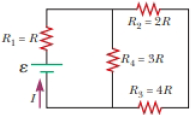
(a)
Answer to Problem 28.16P
Explanation of Solution
The resistors
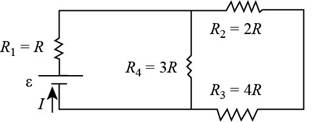
Figure (1)
Formula to calculate the resistance across the circuit when resistors
Here,
Substitute
Thus, the resistance across the circuit when resistors
The resistors
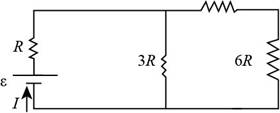
Figure (2)
Formula to calculate the resistance when the resistors are connected in parallel is,
Here,
Substitute
Thus, the value of the resistance when the resistors are connected in parallel is
The resistors
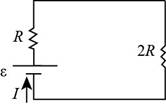
Figure (3)
Formula to calculate the equivalent resistance across the circuit is,
Here,
Substitute
Thus, the equivalent resistance across the circuit is
The equivalent resistance is shown in the figure 4.
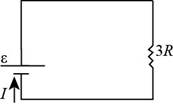
Figure (4)
Formula to calculate the current across the circuit is,
Here,
Substitute
Thus, the current across the circuit is
Formula to calculate the voltage across the
Here,
Substitute
Thus, the voltage across the
Thus, the voltage across the
Formula to calculate the voltage across the
Here,
Substitute
Thus, the voltage across the
Formula to calculate the current across the
Here,
Substitute
Thus, the current across the
Formula to calculate the current across the
Here,
Substitute
Thus, the current across the
Formula to calculate the voltage across the
Here,
Substitute
Thus, the voltage across the
Formula to calculate the voltage across the
Here,
Substitute
Thus, the voltage across the
Conclusion:
Therefore, the potential difference across
(b)
Answer to Problem 28.16P
Explanation of Solution
Formula to calculate the value of
Substitute
Thus, the value of
Formula to calculate the current across the
Here,
Substitute
Substitute
Thus, the current across the
Formula to calculate the current across the
Here,
Substitute
Substitute
Thus, the current across the
Formula to calculate the current across the
Here,
Substitute
Substitute
Thus, the current across the
Formula to calculate the current across the
Here,
Substitute
Substitute
Thus, the current across the
Conclusion:
Therefore, the current across
(c)
Answer to Problem 28.16P
Explanation of Solution
If the value of the
Since, the current remains same in series combination. So, the value of current across
If the value of the
Thus, the current across the
Conclusion:
Therefore, the value of current across
(d)
Answer to Problem 28.16P
Explanation of Solution
If
Here,
The resistors
Formula to calculate the resistance across the circuit when resistors
Here,
Substitute
Thus, the resistance across the circuit when resistors
From equation (11), the value of
From equation (12), formula to calculate the current across the
Here,
Substitute
Thus, the current across the
As the resistors
Here,
Thus, the original current in the battery is
Conclusion:
Therefore, the current across
Want to see more full solutions like this?
Chapter 28 Solutions
Physics for Scientists and Engineers, Technology Update (No access codes included)
- Students are asked to use circular motion to measure the coefficient of static friction between two materials. They have a round turntable with a surface made from one of the materials, for which they can vary the speed of rotation. They also have a small block of mass m made from the sec- ond material. A rough sketch of the apparatus is shown in the figure below. Additionally they have equipment normally found in a physics classroom. Axis m (a) Briefly describe a procedure that would allow you to use this apparatus to calculate the coefficient of static friction, u. (b) Based on your procedure, determine how to analyze the data collected to calculate the coefficient of friction. (c) One group of students collects the following data. r (m) fm (rev/s) 0.050 1.30 0.10 0.88 0.15 0.74 0.20 0.61 0.25 0.58 i. Use the empty spaces in the table as needed to calculate quantities that would allow you to use the slope of a line graph to calculate the coefficient of friction, providing labels with…arrow_forwardPART Aarrow_forwardanswer both questionarrow_forward
- Only part A.) of the questionarrow_forwardIn general it is best to conceptualize vectors as arrows in space, and then to make calculations with them using their components. (You must first specify a coordinate system in order to find the components of each arrow.) This problem gives you some practice with the components. Let vectors A = (1,0, -3), B = (-2, 5, 1), and C = (3,1,1). Calculate the following, and express your answers as ordered triplets of values separated by commas.arrow_forwardIn general it is best to conceptualize vectors as arrows in space, and then to make calculations with them using their components. (You must first specify a coordinate system in order to find the components of each arrow.) This problem gives you some practice with the components. Let vectors A = (1,0, −3), B = (-2, 5, 1), and C = (3,1,1). Calculate the following, and express your answers as ordered triplets of values separated by commas.arrow_forward
- In general it is best to conceptualize vectors as arrows in space, and then to make calculations with them using their components. (You must first specify a coordinate system in order to find the components of each arrow.) This problem gives you some practice with the components. Let vectors A = (1,0, -3), B = (-2, 5, 1), and C = (3,1,1). Calculate the following, and express your answers as ordered triplets of values separated by commas.arrow_forwardfine the magnitude of the vector product express in sq meters what direction is the vector product in -z or +zarrow_forward4) Three point charges of magnitude Q1 = +2.0 μC, Q2 = +3.0 μС, Q3 = = +4.0 μС are located at the corners of a triangle as shown in the figure below. Assume d = 20 cm. (a) Find the resultant force vector acting on Q3. (b) Find the magnitude and direction of the force. d Q3 60° d Q1 60° 60° Q2 darrow_forward
 Physics for Scientists and EngineersPhysicsISBN:9781337553278Author:Raymond A. Serway, John W. JewettPublisher:Cengage Learning
Physics for Scientists and EngineersPhysicsISBN:9781337553278Author:Raymond A. Serway, John W. JewettPublisher:Cengage Learning Physics for Scientists and Engineers with Modern ...PhysicsISBN:9781337553292Author:Raymond A. Serway, John W. JewettPublisher:Cengage Learning
Physics for Scientists and Engineers with Modern ...PhysicsISBN:9781337553292Author:Raymond A. Serway, John W. JewettPublisher:Cengage Learning Principles of Physics: A Calculus-Based TextPhysicsISBN:9781133104261Author:Raymond A. Serway, John W. JewettPublisher:Cengage Learning
Principles of Physics: A Calculus-Based TextPhysicsISBN:9781133104261Author:Raymond A. Serway, John W. JewettPublisher:Cengage Learning Physics for Scientists and Engineers, Technology ...PhysicsISBN:9781305116399Author:Raymond A. Serway, John W. JewettPublisher:Cengage Learning
Physics for Scientists and Engineers, Technology ...PhysicsISBN:9781305116399Author:Raymond A. Serway, John W. JewettPublisher:Cengage Learning
 Physics for Scientists and Engineers: Foundations...PhysicsISBN:9781133939146Author:Katz, Debora M.Publisher:Cengage Learning
Physics for Scientists and Engineers: Foundations...PhysicsISBN:9781133939146Author:Katz, Debora M.Publisher:Cengage Learning





